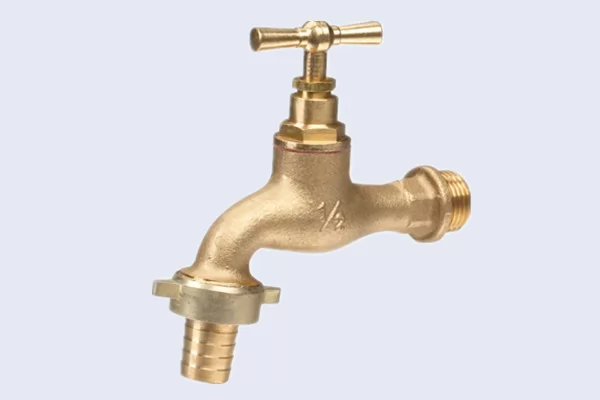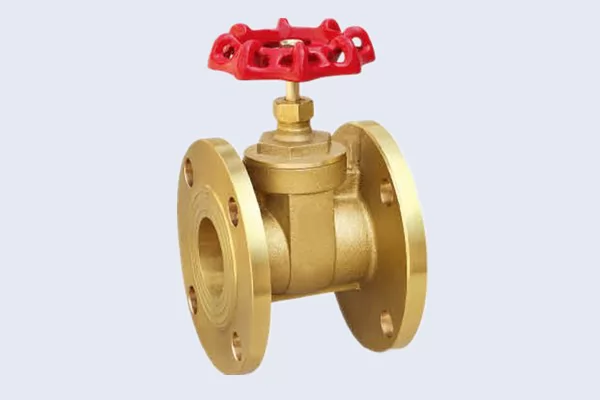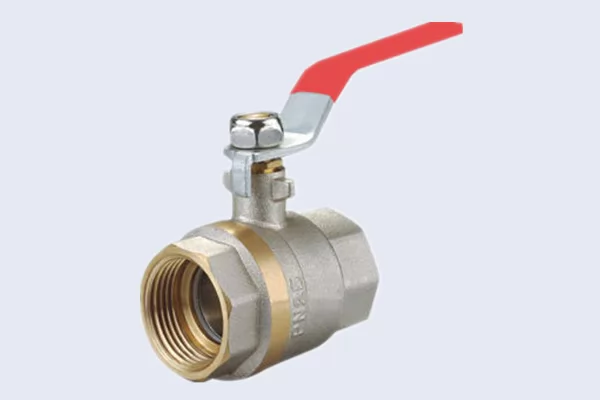Casting valves are valves made by casting. Generally, the pressure of the cast valves is relatively low (such as PN16, PN25, PN40, but sometimes high pressure can reach 1500Lb, 2500Lb, most of the caliber is more than DN50. Forged valves are forged by machinary, generally used on high-grade pipelines, with small calibers, generally below DN50.

Casted brass bibcock
Casting
1. Casting: It is the process of smelting metal into a liquid that meets certain requirements and pouring it into the mold. After cooling and solidifying and clearing, a casting (part or blank) having a predetermined shape, size and performance is obtained. The basic process of the modern machinery manufacturing industry.
2. The blank produced by casting has low cost, and it can show its economicality for parts with complicated shape, especially with complex internal cavity; at the same time, it has wide adaptability and good comprehensive mechanical properties.
3, But the materials required for casting production (such as metal, wood, fuel, modeling materials, etc.) and equipment (such as metallurgical furnace, sand mixer, molding machine, core machine, falling sand machine, shot blasting machine, cast iron plate, etc. There are many, and it will produce dust, harmful gases and noise and pollute the environment.
4. Casting is a metal thermal processing technology mastered by humans. It has a history of about 6,000 years. In 3200 BC, copper frog castings appeared in Mesopotamia. Between 13 BC and the 10th century BC, China has entered the heyday of bronze castings, and its craftsmanship has reached a fairly high level, such as the Shang dynasty's 875 kilograms of the mother Wu Fangding, the Warring States' Zeng Houyi and the Western Han Dynasty. The light-transparent mirrors are all representative products of ancient casting. The early casting was greatly influenced by pottery, and most of the castings were tools or utensils for agricultural production, religion, and life, and the artistic color was strong. In 513 BC, China cast the world's first iron castings found in the text - Jin Guozhu Ding (about 270 kg weight). Around the 8th century AD, Europe began to produce cast iron parts. After the industrial revolution of the 18th century, castings entered a new era of service for large industries. In the 20th century, the development speed of casting was very fast. The development of spheroidal graphite cast iron, malleable cast iron, ultra-low carbon stainless steel and aluminum-copper, aluminum-silicon, aluminum-magnesium alloy, titanium-based, nickel-based alloy and other cast metal materials was developed. A new process for the inoculation of cast iron. After the 1950s, there were new technologies such as wet sand high pressure molding, chemical hardening sand molding and core making, negative pressure molding, and other special casting and shot blasting.
5, A lot of casting types, according to the modeling method habitually divided into: 1 ordinary sand casting, including wet sand type, dry sand type and chemical hardening sand type 3 categories. 2 Special casting, according to the modeling materials, can be divided into special castings with natural mineral sandstone as the main modeling material (such as investment casting, clay casting, casting workshop shell casting, negative pressure casting, solid casting, ceramic casting). Etc.) and special castings with metal as the main casting material (such as metal casting, pressure casting, continuous casting, low pressure casting, centrifugal casting, etc.).
6. The casting process usually includes: 1 mold (the container that makes the liquid metal into a solid casting). The mold can be divided into sand type, metal type, ceramic type, mud type, graphite type, etc. according to the materials used. For disposable, semi-permanent and permanent types, the advantages and disadvantages of casting preparation are the main factors affecting the quality of castings; 2 melting and casting of casting metals, casting metals (casting alloys) mainly include cast iron, cast steel and cast non-ferrous alloys; 3 Casting treatment and inspection, casting processing includes removal of foreign objects on the core and casting surface, removal of pouring risers, burrs and burrs and other projections, as well as heat treatment, shaping, anti-rust treatment and roughing.

Casted Flange Brass Gate Valves
Forging
1. Forging: It is a processing method that uses a forging machine to apply pressure to a metal blank to cause plastic deformation to obtain a forging having a certain mechanical property, a certain shape and a size.
2. One of the two major components of forging. By forging, it can eliminate the looseness of the as-cast state of the metal, weld the hole, and the mechanical properties of the forging are generally superior to those of the same material. For important parts with high load and severe working conditions in machinery, forgings are often used except for rolled sheets, profiles or welded parts that are simple in shape.
3, forging according to the forming method can be divided into: 1 open forging (free forging). The impact force or pressure is used to deform the metal between the upper and lower two irons (anvil) to obtain the required forgings, mainly hand forging and mechanical forging. 2 closed mode forging. The metal blank is subjected to compression deformation in a forging die having a certain shape to obtain a forged piece, which can be classified into die forging, cold heading, rotary forging, extrusion, and the like. Forging at deformation temperature can be further divided into hot forging (processing temperature is higher than recrystallization temperature of billet metal), warm forging (below recrystallization temperature) and cold forging (normal temperature).
4. Forging materials are mainly carbon steel and alloy steel of various compositions, followed by aluminum, magnesium, titanium, copper and the like and alloys thereof. The raw state of the material is bar, ingot, metal powder and liquid metal. The ratio of the cross-sectional area of the metal before deformation to the area of the die after deformation is called the forging ratio. Proper selection of forging ratios has a lot to do with improving product quality and reducing costs.

Forged brass ball valves
How to identify of casted valves and forged valves
1. The fineness of the surface structure of the forging, the surface of the casting should be thicker, and the surface of the forging should be brighter.
2. The cast iron section is grayish and dark, while the forged steel section is bright silver.
3, Listening to the sound, the forging is dense, the sound is crisp after the blow, the casting sound is dull.
4. Use a grinder to polish the sparks of the two (the forgings are bright) and so on.
--------- The End ----------
This article is presented by NAFCO, quality China brass valve manufacturer and supplier, with full line of brass valves China for your selection, such as brass ball valves, brass gate valves,brass radiator valves, brass angle valves, as well as relevant brass fittings. Please don't hesitate to contact us for any questions at support@acrofluid.com.
More articles of brass valves that you may be interested:






